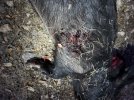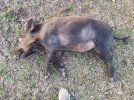oscarflytyer
Well-Known Member
I started with the Lee 405 HB bullet and Waters' Pet Load of 38.5 gr of I-3031 chrono'd at 1350 fps. Accurate/mild/deer slayer - done...I'm probably the only guy in the county who does. But, I know of only one other .45-70 shooter and he prefers
IMR 3031.
I DO have 2 of Michael's molds (300 and 350 iirc). Intend to see what might work, but... That HBRN is a deer thumper as long as you put the RN IN the shoulder and NOT in the lungs! Lung shot will kill, but the hide and seek part SUCKS! I always hit them in the shoulder, but a buddy borrowed it and (and I forgot to tell him shoulder shot! - MY fault!) a lung shot with a slow RN and the deer has no clue for awhile it is dead running... and with the RN - blood trail from lung trail S U C K S!


